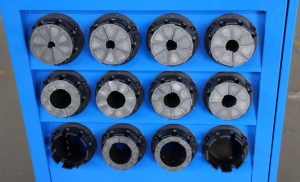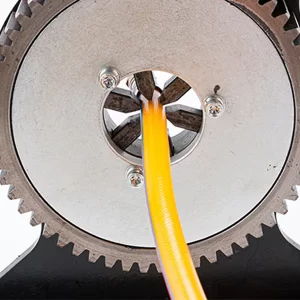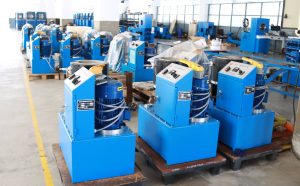What Is a Hydraulic Hose Crimper and How Does It Work?
Hydraulic hose crimpers are essential tools for anyone working with hydraulic systems. Whether you’re in construction, manufacturing, or automotive repair, understanding how hydraulic hose crimpers work can drastically improve the quality and efficiency of your projects. In this article, we’ll explore what hydraulic hose crimpers are, how they operate, and why they are critical to the functioning of hydraulic systems. We’ll also discuss key features to look for, common types of crimpers, and essential safety and maintenance tips. Ready to dive in? Let’s break it all down.
1. What is a Hydraulic Hose Crimper?
A hydraulic hose crimper is a tool designed to attach hydraulic fittings to hoses by compressing them into place. The process, known as crimping, ensures a secure and leak-proof connection, which is crucial for maintaining the integrity of a hydraulic system. But here’s the kicker – without proper crimping, a hose can fail under pressure, leading to system breakdowns or safety hazards.
A hydraulic hose crimper uses a set of dies that match the size and type of the hose. The crimper compresses the fitting onto the hose, forming a tight, permanent bond. There are different types of crimpers, from manual hand-held versions to large, machine-operated systems. Crimpers come in various sizes, with some designed for small DIY jobs and others built for industrial use.
A hydraulic crimper’s importance goes beyond just making connections. Its precision ensures the safety and performance of the entire hydraulic system. This means crimping must be done correctly, with attention to the correct size, fitting, and pressure.
2. Why Should You Use a Hydraulic Hose Crimper?
Using a hydraulic hose crimper offers several advantages. First and foremost, it ensures that the fittings are securely attached, reducing the likelihood of leaks. What’s the real story? A loose fitting can lead to catastrophic failure under high pressure, which could cause costly damage and downtime.
Secondly, crimping provides a quick and reliable method to join hoses and fittings, which is essential when working in fast-paced environments like automotive repair or manufacturing. A properly crimped fitting also maintains the structural integrity of the hose, which is vital in high-pressure systems.
Lastly, hydraulic hose crimpers make the job easier and more efficient. Without a crimper, manually attaching fittings could take far longer and may not provide the same level of security. For businesses focused on efficiency and reliability, investing in a quality hydraulic hose crimper is a no-brainer.
3. How Does a Hydraulic Hose Crimper Work?
Understanding how a hydraulic hose crimper works is key to choosing the right tool for the job. Here’s the breakdown: The crimper uses a set of dies that are shaped to fit the specific diameter and style of the hose and fitting. The hose is placed inside the crimping machine, and the dies compress the fitting onto the hose, creating a tight, secure bond.
This is where it gets interesting… There are different machines designed for different types of crimping jobs. Smaller, manual crimpers are operated by hand, while larger, hydraulic-powered machines offer more force for industrial-grade tasks. The hydraulic-powered crimpers use hydraulic fluid to apply pressure to the crimping dies, which results in much higher compression than what a manual crimper can achieve.
Additionally, modern hydraulic crimpers come with adjustable dies, allowing them to accommodate different hose sizes and types. This flexibility is critical for businesses that deal with various hoses and fittings regularly. Whether you are working with hoses for construction equipment or automotive systems, the correct crimping process ensures the longevity and safety of your hydraulic system.
4. What Are the Types of Hydraulic Hose Crimpers?
Hydraulic hose crimpers come in several types, each designed for specific needs. These include manual, electric, hydraulic, and portable crimpers. But here’s the kicker: each type has its own strengths and weaknesses, so selecting the right one is crucial for your operation.
- Manual Crimpers: These are simple, hand-powered devices suitable for small projects or occasional use. They are affordable and portable but require more physical effort, making them less ideal for high-volume or industrial use.
- Electric Crimpers: These are powered by electricity, making them more efficient than manual crimpers. Electric crimpers are perfect for workshops or small-scale businesses where consistent, reliable crimping is necessary.
- Hydraulic Crimpers: Powered by hydraulic pressure, these machines offer high crimping force, making them ideal for heavy-duty tasks. They are commonly used in industrial settings, where large volumes of crimping are required.
- Portable Crimpers: Designed for fieldwork or mobile applications, these crimpers are lightweight and easy to transport. They are powered by hydraulics or electricity and are perfect for on-the-go jobs that require reliable crimping.
Each type of crimper offers unique advantages depending on the work environment, frequency of use, and hose sizes.
5. How Do You Choose the Right Hydraulic Hose Crimper?
Choosing the right hydraulic hose crimper depends on various factors such as the type of hose you are working with, the scale of your business, and the frequency of crimping required. What’s the real story? The wrong crimper can lead to poor results and additional costs down the road. So, let’s break it down:
- Hose Size and Type: The crimper should be able to handle the hose sizes you work with regularly. Some crimpers are designed for specific hose diameters, while others offer adjustable dies for various sizes.
- Crimping Force: Different crimpers provide varying amounts of pressure. If you are working with high-pressure hoses, you’ll need a crimper that offers sufficient crimping force to ensure a secure fitting.
- Frequency of Use: For a business that crimp hoses frequently, an electric or hydraulic crimper may be more suitable. Manual crimpers are better for occasional use.
- Portability: If you need to perform crimping in the field or on job sites, a portable crimper might be the best option. These are compact, lightweight, and easy to carry.
Choosing a crimper involves balancing your specific needs with the features available. A high-quality crimper can significantly improve the speed and reliability of your work.
6. What Are the Key Features of Hydraulic Hose Crimpers?
When evaluating hydraulic hose crimpers, it’s important to consider several key features that will impact performance, safety, and ease of use. Ready for the good part? Let’s dive into these essential features:
- Crimping Force: The crimper’s ability to apply pressure is one of the most crucial factors. For heavy-duty applications, look for crimpers with high crimping force that can handle tougher materials and higher pressures.
- Adjustable Dies: Crimpers with adjustable dies offer flexibility, allowing you to handle a variety of hose sizes and types without needing a different machine for each one.
- Ease of Use: Features like ergonomic handles, simple controls, and quick setup make the crimper easier to use, especially when performing multiple crimping jobs a day.
- Durability and Maintenance: A durable crimper can handle frequent use without requiring constant repairs. Look for models made from high-quality materials with easy-to-service components to extend the machine’s lifespan.
These features will ensure your crimper performs well and stands the test of time, keeping your business operations running smoothly.
7. Where Are Hydraulic Hose Crimpers Used?
Hydraulic hose crimpers play an essential role in various industries where hydraulic systems are common. Here’s the deal – without reliable hose connections, machinery and systems can fail. That’s why these crimpers are so important in sectors like:
- Construction: Hydraulic systems are used in heavy machinery like excavators, bulldozers, and cranes. Crimpers ensure the hoses are securely fitted to withstand tough conditions and high pressure.
- Automotive: Crimpers are used to attach hydraulic hoses to car parts, ensuring that vehicles have efficient and safe braking systems and power steering systems.
- Agriculture: Crimpers are commonly used in farming equipment like tractors and harvesters, where hydraulic systems power various machinery components.
In short, crimpers are used wherever there’s a need for high-pressure, secure hose connections, making them indispensable across a variety of industries.
8. What Are the Different Hose Crimping Sizes Available?
Hydraulic hoses come in various sizes, and so do the crimping machines that fit them. But here’s the kicker – if your crimper can’t handle the size of the hose you’re working with, you won’t get a secure fitting. Hose sizes are determined by the internal diameter and the external diameter, both of which need to match the crimper’s specifications.
Crimpers typically handle a wide range of hose sizes, with models designed for everything from small hoses used in automotive systems to large hoses used in industrial machinery. When choosing a crimper, it’s important to know the specific sizes of hoses you’ll be working with regularly.
Here’s a quick look at common hose sizes and their uses:
| Hose Size | Use Case |
|---|---|
| 1/4 inch | Small machinery, automotive |
| 1/2 inch | Medium machines, construction |
| 1 inch | Heavy-duty machinery, industry |
| 2 inch | Large-scale industrial machines |
Selecting the right crimper ensures a secure, tight fit every time.
9. What Materials Are Hydraulic Hose Crimpers Compatible With?
Hydraulic hose crimpers are designed to work with various materials, including rubber, thermoplastics, and steel. This is where it gets interesting – each material requires specific attention during the crimping process. Here’s a breakdown:
- Rubber: Often used in flexible hoses for automotive and construction applications, rubber hoses require careful crimping to avoid kinks or leaks.
- Thermoplastics: These hoses are common in lighter-duty systems and require crimpers that provide adequate pressure to form a tight seal without damaging the material.
- Steel: Steel-braided hoses are tough and designed for high-pressure applications. Crimping them requires a crimper with higher crimping force to maintain a secure and leak-proof fitting.
Understanding the material of the hose ensures that the crimping process won’t compromise the integrity of the hose, regardless of its construction.
10. How Do You Maintain a Hydraulic Hose Crimper?
Regular maintenance is crucial to keeping your hydraulic hose crimper in top shape. What’s the real story? If you don’t maintain your crimper, its performance will degrade over time, leading to poor crimps and potentially unsafe hose connections.
Maintenance tasks include:
- Cleaning: After each use, clean the crimper to remove any debris, dirt, or oil buildup that can interfere with its performance.
- Lubrication: Keep moving parts lubricated to prevent rust and reduce friction, which can damage the internal components.
- Inspection: Regularly inspect the dies and other components for wear and tear. Replace worn-out parts promptly to avoid further damage.
Proper maintenance will extend the lifespan of your crimper and ensure consistent, high-quality results.
11. What Are the Safety Precautions for Using Hydraulic Hose Crimpers?
Using hydraulic hose crimpers involves working with high-pressure systems, so safety is a top priority. This is where it gets interesting… Failure to follow safety precautions can result in accidents, injuries, or costly equipment damage. Here are some safety tips:
- Wear protective gear: Always wear safety glasses, gloves, and other protective clothing when operating a hydraulic crimper.
- Proper setup: Before starting, ensure that the hose and fitting are properly aligned and secured in the crimper.
- Avoid over-pressurization: Ensure that the crimper applies the correct amount of pressure. Too much force can damage the hose or cause it to rupture.
By following these precautions, you can minimize risks and ensure the crimping process is done safely.
12. How Long Does a Hydraulic Hose Crimper Last?
The lifespan of a hydraulic hose crimper depends on several factors, such as the type of crimper, how often it is used, and how well it is maintained. What’s the real story? A well-maintained crimper can last for many years, but regular use without proper upkeep can shorten its lifespan significantly.
On average, hydraulic hose crimpers last between 5 to 10 years, depending on the brand and usage frequency. However, with proper care and maintenance, this lifespan can be extended.
Regular maintenance, such as cleaning, lubrication, and part replacements, is key to ensuring that your crimper performs efficiently for as long as possible.
13. How Do Hydraulic Hose Crimpers Compare to Other Crimping Methods?
When it comes to crimping hoses, hydraulic hose crimpers are often superior to manual methods. But here’s the kicker – while manual crimping may suffice for smaller projects, hydraulic crimpers provide superior strength, precision, and efficiency, making them the go-to tool for professionals.
Hydraulic crimpers also require less physical effort, making them easier to use and more suitable for high-volume applications. They offer consistent, repeatable results that manual crimpers can’t match.
| Feature | Manual Crimper | Hydraulic Crimper |
|---|---|---|
| Force Required | High | Low |
| Speed | Slow | Fast |
| Consistency | Low | High |
| Ideal for | Small jobs | Industrial jobs |
Hydraulic hose crimpers outperform manual crimpers in almost every aspect, especially when it comes to heavy-duty applications.
14. What Are the Costs of Hydraulic Hose Crimpers?
The cost of a hydraulic hose crimper can vary significantly based on factors like type, size, and brand. What’s the real story? While manual crimpers are relatively inexpensive, hydraulic models come at a higher price but offer greater performance and durability.
Here’s a general breakdown:
| Crimper Type | Price Range |
|---|---|
| Manual Crimpers | $50–$300 |
| Electric Crimpers | $300–$1,500 |
| Hydraulic Crimpers | $1,000–$10,000 |
Although the upfront cost is higher for hydraulic crimpers, their efficiency and longevity often justify the investment for businesses.
15. How Do You Set Up a Hydraulic Hose Crimper for a Job?
Setting up a hydraulic hose crimper is a straightforward process, but it requires precision. This is where it gets interesting… A well-set-up crimper ensures that the crimping process goes smoothly, leading to high-quality, secure connections.
To set up your crimper:
- Choose the right die size for the hose and fitting you are working with.
- Align the hose and fitting properly in the crimper to ensure the dies compress them correctly.
- Check the pressure settings to make sure they are within the recommended range for the hose material and pressure rating.
Proper setup reduces the likelihood of mistakes and ensures that the crimping is done right the first time.
FAQ Section
Q1: What is a hydraulic hose crimper?\
A hydraulic hose crimper is a tool used to attach fittings to hydraulic hoses by applying pressure to compress them securely in place.
Q2: How does a hydraulic hose crimper work?\
A hydraulic hose crimper uses a set of dies that apply pressure to compress a fitting onto a hose, ensuring a tight, leak-proof connection.
Q3: What are the types of hydraulic hose crimpers?\
Hydraulic hose crimpers include manual, electric, hydraulic, and portable crimpers, each designed for different tasks and usage scenarios.
Q4: How do I choose the right hydraulic hose crimper?\
Choosing the right crimper depends on factors like hose size, pressure requirements, and the frequency of use.
Q5: What maintenance is required for a hydraulic hose crimper?\
Regular maintenance includes cleaning, lubricating moving parts, and inspecting the dies for wear and tear to ensure consistent performance.




